From the majestic Great Blue Heron to the elusive Green Heron, these 9 types of herons are a sight to behold.
Each with its own distinct characteristics, these wading birds are a common sight in wetlands and along coastlines worldwide.
With their striking plumage and impressive hunting abilities, herons have fascinated ornithologists and bird watchers for centuries.
But, do you know all 9 types of herons and their distinct features? Read on to find out!
| Image | Name |
|---|---|
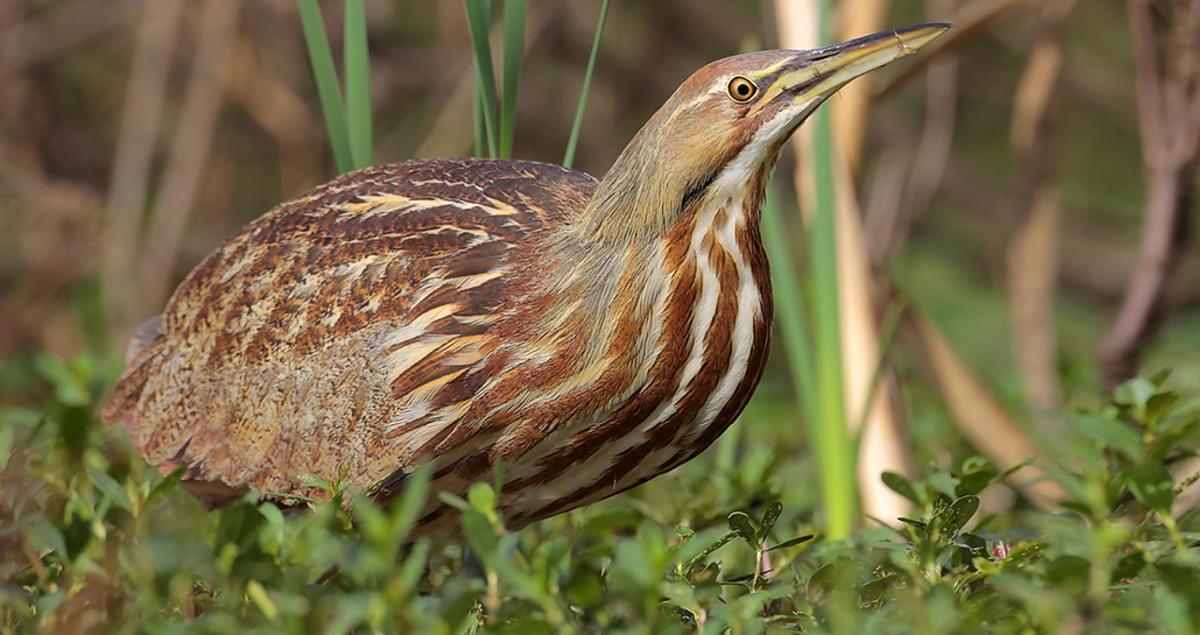 | American Bittern |
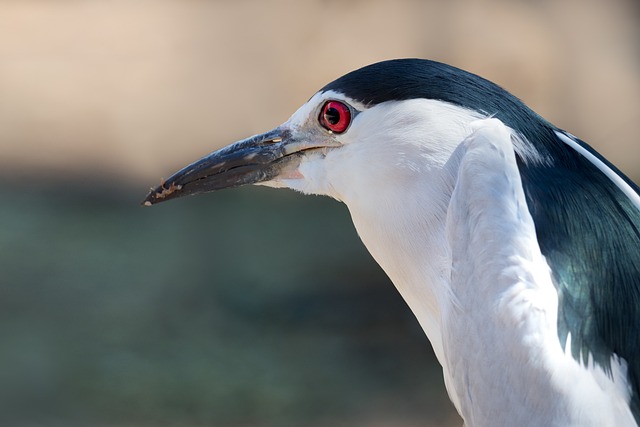 | Black-crowned Night-Heron |
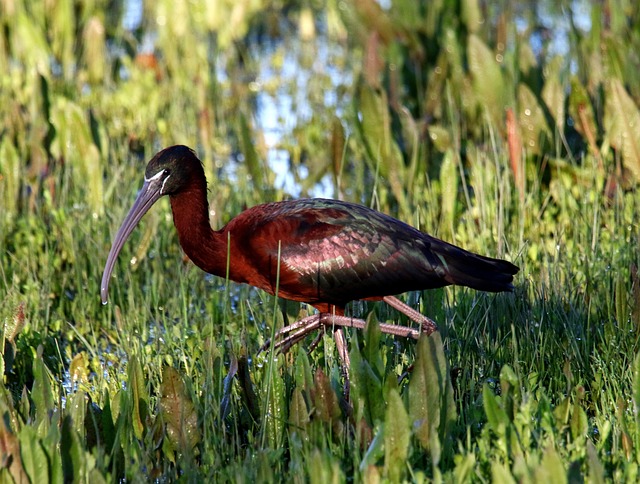 | Glossy Ibis |
 | Great Blue Heron |
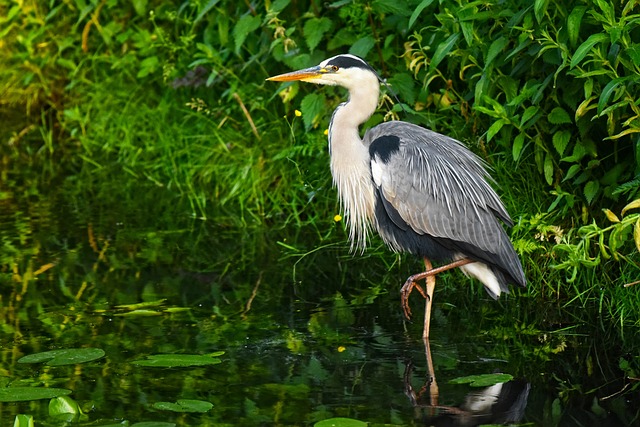 | Green Heron |
 | Least Bittern |
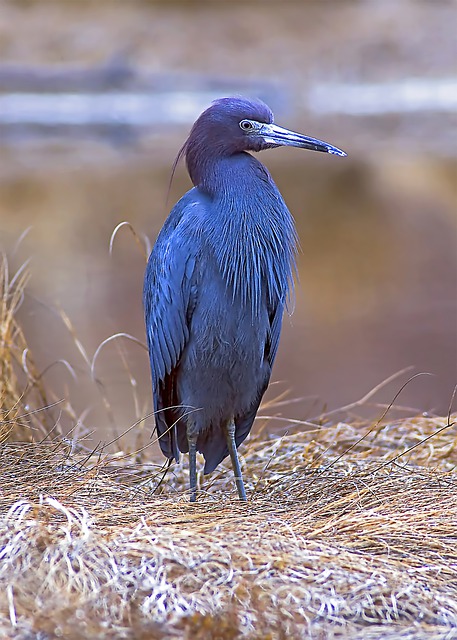 | Little Blue Heron |
 | Roseate Spoonbill |
 | Tricolored Heron |
Types of Herons
1. American Bittern

An American Bittern is a hard bird to see.
This brown and white heron may emerge out of nowhere and vanish just as fast amid the reeds.
Thanks to its adept use of the concealing crouch, which consists of a stretched neck and a bill pointing upwards.
These silent predators wait quietly in ambush for prey such as fish, frogs, and insects among the thick marsh plants.
During the spring, their strange booming noises may be heard across the marshes, and they sound like the gulps of a thirsty monster.
In most cases, you’re more likely to hear an American Bittern than see one. Names like “thunder-pumper,” “stake-driver,” “mire-drum,” and “water-belcher” describe their loud, clacking, gulping cries.
The territorial aggression of male American Bitterns is used by researchers seeking to capture the birds for study.
Researchers utilize recorded sounds and mirrors to lure the birds in since they know the birds will react to the cries of other males from up to 1,600 feet distant.
Because of this, the American Bittern’s face sometimes looks humorously frightened and cross-eyed.
The bird’s ability to see and catch its prey is likely improved by this trait.
During mating season, the eyes will change to an orange hue.
Eight years after being banded as an adult in 1940, the oldest known American Bittern was discovered in Ontario.
It was approximately eight years and four months old.
The American Bittern is elusive, yet its numbers are not insignificant.
It is possible to see these animals by scanning the peaceful, reedy marshes from the viewing towers and boardwalks of a nearby wildlife refuge or swamp park.
To detect the bittern, use binoculars or a sighting scope and attentively pan along the boundary between the water and the reeds.
Remember that your eyes will have to work extra hard due to the creature’s ability to blend into its environment.
With any hope, a dry area of reeds will transform into a stationary bittern.
You have a far better chance of seeing one if you go there in the spring and keep an ear out for their peculiar pump-err-lunk cry.
2. Black-crowned Night-Heron

Many of the heron’s cousins have slender, long bodies, but the heron is stocky.
At twilight or dusk, you could witness their ethereal shapes fluttering out of daytime roosts to feed nearby wetlands when they are most active.
Adults are very impressive in the daytime, with their grey and black feathers and large white head feathers.
These birds are colonial breeders that construct their stick nests mostly above bodies of water.
They are among the most widely distributed heron in the world, found in both freshwater and marine environments.
Nestling Black-crowned Night-Herons typically vomit when approached, making it easier for scientists to research what they eat (although unpleasant and stinky).
Many other kinds of birds, such as other egrets, herons, and ibises, will congregate around a black-crowned night heron nest.
Any chick put in the nest of a mating Black-crowned Night-Heron will be raised by the heron as its own.
It would seem that the herons do not tell their young apart from those of other parents.
Black-crowned Night-Herons fledge (leave the nest) around one month of age but are unable to fly for another six weeks.
They go on foot through the undergrowth and gather in large flocks to go out foraging at night.
It was determined in 2012 that a female Black-crowned Night-Heron throughout California has been a minimum of 21 years and five months old.
By 1992, she was one of the many victims of their banding policies.
All around North America, you can see black-crowned night herons in wetland areas; however, you might need to search a bit harder than you would for other herons.
According to their names, these birds spend much of the day huddled between leaves and branches along the water’s edge, where they perform most of their foraging at night.
At dark and night, you could see one of these stocky, short-necked herons on its way to its hunting grounds.
3. Glossy Ibis

To the untrained eye, Glossy Ibises seem completely black, but a closer inspection in bright light shows a kaleidoscope of deep green, maroon, violet, and silver.
This long-legged and -billed bird travels in large groups across marshes and damp agricultural areas in quest of seeds, insects, and tiny fish.
The birds are migratory to some extent, spreading out over a large area once the breeding season is through, a behavior that has helped the species extend its territory from the southern United States to most of eastern North America in the last century.
As they cautiously advance into a muddy region, flocks of Glossy Ibis graze quite closely together.
Wading birds like Great Blue Herons and Snowy Egrets frequently gather to feast on the minnows and other fish that swim away from the flocks of ibises that have come to feed.
Colonies of Glossy Ibises are common, and they often nest with other egrets, herons, ibis, and spoonbill species.
When it comes to warding off potential danger, colonial nesters have a significant edge.
Colonies may also be a site where social creatures like ibises may learn from one another about the best places to get food.
Aside from its native range in Africa, the Glossy Ibis may be found throughout Asia, the Middle East, and Europe.
Its population has exploded in recent decades, perhaps due to more rice being grown in the country.
Banded glossy ibises from Spain have been found in Barbados, proving that the birds can fly across the Atlantic.
This is an impressive achievement, but it has been accomplished by other heron and egret species as well.
Between 1971 and 1992, a Glossy Ibis in Virginia survived to be a minimum of 22 years old.
Glossy Ibises may be found in a variety of habitats, including saltwater wetlands, brackish and freshwater wetlands, rice fields, and mangroves.
In many parts of its distribution, Glossy Ibises are only seen seldom or only in small areas; contacting local birders for aid is a good idea.
Keep an eye out for a large bird (or birds) that saunter leisurely around open marshes in search of food or that flies with its neck and feet splayed out.
The spotting scope that most bird walk leaders carry is a great tool for getting up and personal with these elusive creatures.
4. Great Blue Heron

The Great Blue Heron is a spectacular sight, whether it’s perched on the bank of a river or gliding along the shore.
The blue-gray heron is known for its dignified posture and slow, methodical movements as it searches for food.
A Great Blue Heron can move more slowly, but when it wants to catch a fish or catch a gopher, it may attack like lightning.
On the wing, this widespread heron may be identified by its tucked-in neck and its long legs trailing after.
Because of their hollow bones, which is a characteristic of all birds, Great Blue Herons only weigh around five to six lbs despite their massive size.
The resurgence of beaver populations in the northeastern United States and southern Canada has helped Great Blue Herons by creating a mosaic of meadows and wetlands ideal for breeding and feeding.
One may frequently spot a Great Blue Heron perched on a seaweed bed all along the Pacific coast, patiently waiting for a fish to swim around.
The “great white heron,” a variant of the Great Blue Heron that prefers shallow marine waters, is restricted to the Yucatan Peninsula, the Caribbean, and the coasts of extreme southern Florida.
Wurdemann’s herons are transitional birds spotted across Florida, where the ranges of the dark and white varieties meet. A Great Blue Heron’s body, but a Great White Heron’s neck and head.
The Great Blue Heron’s breast plumage is unique and constantly changing as they develop and tear.
Preening herons clear fish slime as well as other oils from their coats by combing them down with a hooked paw on their middle toes.
With this powder applied to their undersides, their feathers will be safe from the oils and filth found in wetlands.
The large concentration of rod-type photoreceptor cells in the eyes of great blue herons allows them to hunt effectively both during the day and at night.
The aggregation of Great Blue Herons at fish hatcheries poses a threat to the commercial fish farming industry.
Researchers discovered that herons mostly fed on dying, sick fish. Ill fish tended to float closer to the water’s surface, making them an easy target for herons.
At least twenty-four years and six months had passed in Texas when scientists discovered the oldest known Great Blue Heron.
Great Blue Herons have vertebrae in their necks that are uniquely formed, allowing them to rapidly and accurately hit distant prey.
Look for this large, sedentary heron along the shores of the United States marshes, rivers, ponds, and estuaries.
Great Blue Herons may also be seen in open spaces like farms and meadows.
You may spot heron colonies, called “heronries,” near human settlements by the large stick nests the birds build in the canopy.
Once you learn to identify their very slow wingbeats and huge shadows, you’ll also begin to take note of these birds in the sky.
5. Green Heron

The Green Heron is often a black, stocky bird that sits hunched on long, yellow legs at the shore of the lake, usually out of sight due to the dense vegetation that surrounds it.
When seen up close, this bird is very magnificent, with a velvet-green back, rich brown body, and a black cap that is often lifted into a small crest.
These little herons wait quietly in a crouched position, ready to pounce with their sharp beaks.
It’s not uncommon for them to use twigs or insects as bait to catch fish.
Among a group of similar tiny herons, including the Green Heron, they are sometimes treated as a single species. Generally speaking, we refer to all of them as Green-backed Herons.
They are the Green Heron, the more common Striated Heron, and the Galapagos Heron when separated.
Only a few of bird species are really useful tools, and the Green Heron is among them.
Bread crusts and plumage are common components of the fishing lures it fashions and then drops on the water’s surface in an attempt to catch tiny fish.
While Green Herons typically hunt by wading through shallow water, they have been seen diving for deep-water food and then having to return to shore, most likely with the assistance of the webs connecting their inner and outer toes.
One witness saw a young heron swim over Sixty feet while sitting erect “like a tiny swan.”
Once the nesting season is finished, the Green Heron, like many other herons, often forages outside of its nesting region.
The majority of the rovers don’t go far from home in their pursuit of suitable eating grounds, but some do.
People have been located in places like France and England.
In 2021, a Green Heron that was estimated to be at least Eight years old was discovered in Texas. There they were officially registered in 2013.
Although prevalent, it may take some time to see a Green Heron.
Green Herons are more likely to be found in the intertidal zone, on the fringes of wetlands, or hidden behind the vegetation, as opposed to the open areas where bigger herons congregate.
When you go to a wetland, search for a little bird with a hunched back and a long, straight beak that is fixedly peering into the water.
Their show call, which is harsh, is also an indicator. A Green Heron in flight is easily recognizable because of the slow, crow-like beats of its rounded wings.
In addition, they are easy to spot because they have a distinct flying pattern that includes the characteristic quick unfolding of the neck.
6. Least Bittern
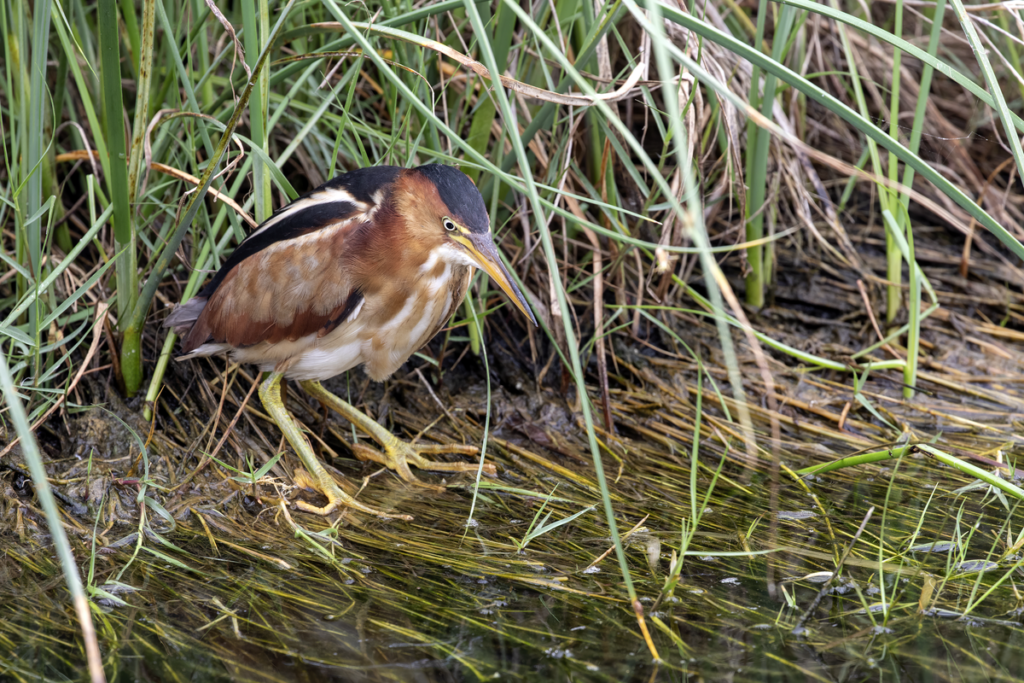
For the most part, the elusive Least Bittern is no more than a sound in the reeds, making it very difficult to see.
Birdwatchers who are patient enough to track down these little herons in their marsh habitats will be rewarded with a delightful encounter.
The male is more deeply pigmented than the female, although both are stylishly dressed in brown, creamy, and black.
Least Bitterns are still present over most of their former range, with the greatest visibility occurring during the mating season, despite the fact that draining and construction of wetlands have diminished their numbers.
When startled, the Least Bittern will stand stock still with its bill pointed upwards, shift its eyes in the direction of the alarm, and even sway slightly to mimic the movement of marsh plants in the wind.
Unlike the bigger and longer-legged American Bittern, the smaller and shorter-legged Least Bittern prefers places having deeper water.
The large, dexterous toes and bent claws of the least bittern make it possible for the bird to grab reeds and hunt tiny animals while hung from these dangerous over-water perches.
Cory’s Least Bittern, a rare black subspecies of Least Bittern, was formerly thought to be a distinct species.
Since its discovery in Florida in 1885, this unique bird has been greatly sought after by so-called “bird collectors” because of its striking appearance (black beak, black back, and rich brown face, abdomen, and wing coverts).
The loral region (between the beak and the eye) of the Least Bittern, like that of many other tiny herons, is devoid of feathers and may change color based on the bird’s mood or activity.
When males are engaged in sexual behavior like copulation, wooing, or territorial fighting, their ordinarily yellowish skin may flush vibrant cherry red, making them a sight to see in the summer and spring months.
In western New York, scientists followed nesting Least Bitterns and discovered that the birds occupied an area equivalent to 10 city blocks, or 24 acres while foraging for food for themselves and their young.
In the months of May and June, before the heat of the day becomes too intense, plan an early morning trip to a brackish or fresh marsh having tall, thick vegetation such as cattail.
To find where the birds are hunting, you should look for waterways or ledges.
Listen for the fast, quiet cooo-cooo-cooo sound of males as you amble gently.
When the birds are flying to and from their roosts and food sources or bringing their catch back to the nest, you may get sight of them.
7. Little Blue Heron

The Little Blue Heron, a little, gloomy heron decked out in a variety of shades of purple and blue, is a frequent but unremarkable dweller of Southeasterly marshes and estuaries.
They hunt in shallow waterways for fish and frogs, and their meticulous, unassuming behavior may make these beautiful herons easy to miss.
Like other colonial waterbirds, Little Blue Herons construct stick nests in trees.
Since the beginning of the twentieth century, their numbers in the United States have been steadily falling.
Because Little Blue Herons don’t have any particularly flashy “aigrette plumes,” they were spared during the mass slaughter of other heron and egret species during the early 20th century when feathered hats were all the rage.
In their first year after life, Little Blue Herons can have an edge if they dress in white.
Snowy Egrets are more likely to accept juvenile birds than blue herons, and when fishing with egrets, the juveniles have a greater chance of success.
Juvenile Small Blue Herons likely obtain additional protection from predators when they join mixed-species groups of white herons.
At least 14 years and 11 months have passed in the life of the eldest Little Blue Heron ever recorded.
It was banded across Virginia in 1957 and later discovered near Maryland in 1971.
This heron is quite hard to see, so be sure to look closely at the margins of shallow water, especially if there is nearby emergent foliage or overhanging shrubs or trees.
Although you’ll most often observe them alone or in pairs, herons and egrets will sometimes congregate to feed on a school of tiny fish that have been caught in shallow water.
Little blue herons may be seen gliding gently through the air on their rounded wings in wide, marshy settings.
If you happen across a colony of nesting waterbirds, keep an eye out for any little herons with all-black feathers.
8. Roseate Spoonbill

The Roseate Spoonbill’s flashy pink plumage, red eye peeking out of a mostly bald head, and enormous spoon-shaped bill make it appear as if it was plucked from a Dr. Seuss book.
Spoonbills are used in flocks to capture crabs and fish in shallow freshwater or salt water.
They fly with necks extended to and from feeding and breeding locations throughout the coastal southern U.S. and south to South America.
These gregarious birds nest and perch in trees and bushes with other big wading birds.
Of the seven species of spoonbills inside the globe, only the Roseate Spoonbill is native to the Americas.
These regions also host the other five species of spoonbill: Royal, Eurasian, African, Yellow-billed, and Black-faced.
Hair thinning is a natural part of aging, and it’s something every human being has to deal with.
It has been discovered that roseate spoonbills, like humans, experience baldness as they age, although in their case, the thinning of feathers on their crown is a result of natural shedding rather than genetics.
Young Roseate Spoonbills do not emerge from the nest with a fully formed spoonbill. When they reach ten days old, the bill begins to flatter; by 15 days, it starts to seem a little more spoonlike; and by 38 days, it is almost full size.
The diets of roseate spoonbills provide the pigment that gives them their distinctive pink plumage.
Carotenoids are pigments found in crustaceans and other aquatic invertebrates, and they contribute to the pink coloration of their feathers.
A Roseate Spoonbill that was caught and released for research in Florida in 2006 has been at least 14 years and ten months old.
If you want to see a Roseate Spoonbill, you’ll probably have to go to the southeast coast of the United States or maybe even farther away from Mexico or Central or South America.
Often accompanied by egrets and ibises, pink birds may be seen in large flocks grazing in the shallows of both fresh and saline water.
Their spoon-shaped beak is used for underwater foraging, so it could not be the first feature you see.
Unlike herons and egrets, they often keep their bodies vertically while foraging. With this stance, you can easily identify them even at great distances.
If you don’t hear them while they’re out hunting, you may find them roosting on the adjacent mangroves, cypress trees, or willows.
9. Tricolored Heron

The Tricolored Heron, sometimes called the Blue-gray Heron, is a tall, lean bird with a variety of colors on its feathers.
Differentiating it from other black herons are the white stripe along the center of its serpentine neck and its white abdomen.
In the pursuit of its prey, this little heron may be seen dashing in a balletic pattern along the coastal waters.
It lives in colonies with other shorebirds, where it constructs nests out of sticks in trees and bushes.
Historically called the Louisiana Heron, this species is now mostly found in southern salt marshes.
When Double-crested Cormorants or Pied-billed Grebes churn up fish, Tricolored Herons may sometimes follow in their snap and wake them up.
Teenage angst isn’t unique to humans. When their parents return to the nest with food, older Tricolored Herons may typically rush and snap at them.
Parents bend before their children in an effort to satisfy them.
The earliest Tricolored Heron on record lived in the Bahamas and was shot in 1976, making it at least 16 years and eight months old.
In 1958, it was banded across Virginia.
Tricolored Herons may be seen all through the year in coastal estuaries.
Look for the blackbird that is likely to be by itself or on the edges of clusters of other waders.
The great blue heron prefers wide water and pools over the shallower waters of the snowy egret and the small blue heron while foraging.
They are easily distinguished from Little Blue Herons and Reddish Egrets by their white bellies and from the sluggish and methodical Great Blue Heron by their aggressive foraging behavior.
Conclusion
While some heron species are easily identifiable even at a look, some require a little more effort.
Now that you know all the ins and outs of these long-legged birds, you won’t be at a loss the next occasion you go sightseeing or bird-watching and come across one of these herons in its native environment.
FAQ
What are the different types of herons?
There are many different species of herons, but some of the most common include the great blue heron, the green heron, the black-crowned night heron, and the little blue heron.
Where can herons be found?
Herons can be found on every continent except Antarctica. They are most commonly found near bodies of water such as wetlands, marshes, and swamps.
What do herons eat?
Herons are opportunistic feeders and will eat a variety of prey including fish, frogs, crustaceans, and small mammals.
How do herons hunt for food?
Herons hunt for food by standing still in shallow water, waiting for prey to come within striking range. They then spear their prey with their sharp beak. Some herons also hunt by wading through water, using their long legs to stir up prey.
What is the average size of a heron?
The size of herons can vary greatly depending on the species. The great blue heron, for example, can grow up to 4 feet tall with a wingspan of up to 6 feet. The green heron, on the other hand, is only about 2 feet tall with a wingspan of around 3 feet.
Are herons endangered?
While some heron species are considered to be of least concern, others are considered to be endangered or threatened due to habitat loss and other factors. It is important to protect and conserve heron habitats to ensure the survival of these species.
Do herons migrate?
Some heron species migrate, while others do not. For example, the great blue heron will migrate to warmer climates during the winter, while the green heron is a non-migratory species.
Last Updated on March 22, 2023 by Lily Aldrin

On #5 the Green Heron, you accidentally put a photo of a regular blue heron there. That coloring and size aren’t matching the green heron.
Are they really considering the Galapagos Heron a form of green heron? It appears to be the same as the yellow crested night heron, which size and coloration is much more similar to the regular blue heron other than the black mask and slightly shorter sturdy looking beak.